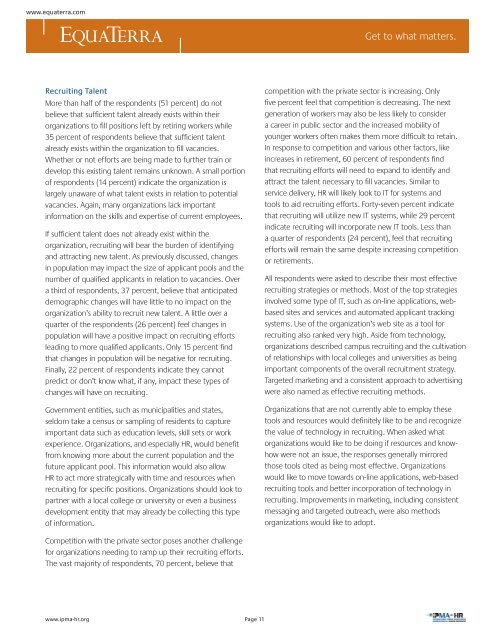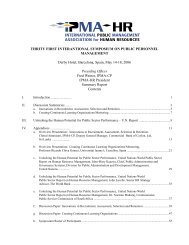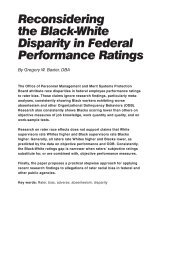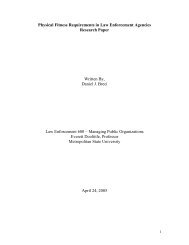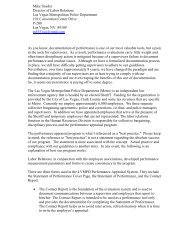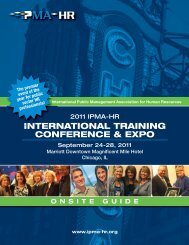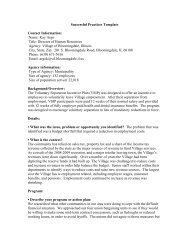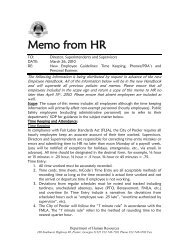The Impact of the Aging Workforce on Public Sector Organizations ...
The Impact of the Aging Workforce on Public Sector Organizations ...
The Impact of the Aging Workforce on Public Sector Organizations ...
Create successful ePaper yourself
Turn your PDF publications into a flip-book with our unique Google optimized e-Paper software.
www.equaterra.comGet to what matters.Recruiting TalentMore than half <str<strong>on</strong>g>of</str<strong>on</strong>g> <str<strong>on</strong>g>the</str<strong>on</strong>g> resp<strong>on</strong>dents (51 percent) do notbelieve that suffi cient talent already exists within <str<strong>on</strong>g>the</str<strong>on</strong>g>irorganizati<strong>on</strong>s to fi ll positi<strong>on</strong>s left by retiring workers while35 percent <str<strong>on</strong>g>of</str<strong>on</strong>g> resp<strong>on</strong>dents believe that suffi cient talentalready exists within <str<strong>on</strong>g>the</str<strong>on</strong>g> organizati<strong>on</strong> to fi ll vacancies.Whe<str<strong>on</strong>g>the</str<strong>on</strong>g>r or not efforts are being made to fur<str<strong>on</strong>g>the</str<strong>on</strong>g>r train ordevelop this existing talent remains unknown. A small porti<strong>on</strong><str<strong>on</strong>g>of</str<strong>on</strong>g> resp<strong>on</strong>dents (14 percent) indicate <str<strong>on</strong>g>the</str<strong>on</strong>g> organizati<strong>on</strong> islargely unaware <str<strong>on</strong>g>of</str<strong>on</strong>g> what talent exists in relati<strong>on</strong> to potentialvacancies. Again, many organizati<strong>on</strong>s lack importantinformati<strong>on</strong> <strong>on</strong> <str<strong>on</strong>g>the</str<strong>on</strong>g> skills and expertise <str<strong>on</strong>g>of</str<strong>on</strong>g> current employees.If suffi cient talent does not already exist within <str<strong>on</strong>g>the</str<strong>on</strong>g>organizati<strong>on</strong>, recruiting will bear <str<strong>on</strong>g>the</str<strong>on</strong>g> burden <str<strong>on</strong>g>of</str<strong>on</strong>g> identifyingand attracting new talent. As previously discussed, changesin populati<strong>on</strong> may impact <str<strong>on</strong>g>the</str<strong>on</strong>g> size <str<strong>on</strong>g>of</str<strong>on</strong>g> applicant pools and <str<strong>on</strong>g>the</str<strong>on</strong>g>number <str<strong>on</strong>g>of</str<strong>on</strong>g> qualifi ed applicants in relati<strong>on</strong> to vacancies. Overa third <str<strong>on</strong>g>of</str<strong>on</strong>g> resp<strong>on</strong>dents, 37 percent, believe that anticipateddemographic changes will have little to no impact <strong>on</strong> <str<strong>on</strong>g>the</str<strong>on</strong>g>organizati<strong>on</strong>’s ability to recruit new talent. A little over aquarter <str<strong>on</strong>g>of</str<strong>on</strong>g> <str<strong>on</strong>g>the</str<strong>on</strong>g> resp<strong>on</strong>dents (26 percent) feel changes inpopulati<strong>on</strong> will have a positive impact <strong>on</strong> recruiting effortsleading to more qualifi ed applicants. Only 15 percent fi ndthat changes in populati<strong>on</strong> will be negative for recruiting.Finally, 22 percent <str<strong>on</strong>g>of</str<strong>on</strong>g> resp<strong>on</strong>dents indicate <str<strong>on</strong>g>the</str<strong>on</strong>g>y cannotpredict or d<strong>on</strong>’t know what, if any, impact <str<strong>on</strong>g>the</str<strong>on</strong>g>se types <str<strong>on</strong>g>of</str<strong>on</strong>g>changes will have <strong>on</strong> recruiting.Government entities, such as municipalities and states,seldom take a census or sampling <str<strong>on</strong>g>of</str<strong>on</strong>g> residents to captureimportant data such as educati<strong>on</strong> levels, skill sets or workexperience. Organizati<strong>on</strong>s, and especially HR, would benefi tfrom knowing more about <str<strong>on</strong>g>the</str<strong>on</strong>g> current populati<strong>on</strong> and <str<strong>on</strong>g>the</str<strong>on</strong>g>future applicant pool. This informati<strong>on</strong> would also allowHR to act more strategically with time and resources whenrecruiting for specifi c positi<strong>on</strong>s. Organizati<strong>on</strong>s should look topartner with a local college or university or even a businessdevelopment entity that may already be collecting this type<str<strong>on</strong>g>of</str<strong>on</strong>g> informati<strong>on</strong>.competiti<strong>on</strong> with <str<strong>on</strong>g>the</str<strong>on</strong>g> private sector is increasing. Onlyfi ve percent feel that competiti<strong>on</strong> is decreasing. <str<strong>on</strong>g>The</str<strong>on</strong>g> nextgenerati<strong>on</strong> <str<strong>on</strong>g>of</str<strong>on</strong>g> workers may also be less likely to c<strong>on</strong>sidera career in public sector and <str<strong>on</strong>g>the</str<strong>on</strong>g> increased mobility <str<strong>on</strong>g>of</str<strong>on</strong>g>younger workers <str<strong>on</strong>g>of</str<strong>on</strong>g>ten makes <str<strong>on</strong>g>the</str<strong>on</strong>g>m more diffi cult to retain.In resp<strong>on</strong>se to competiti<strong>on</strong> and various o<str<strong>on</strong>g>the</str<strong>on</strong>g>r factors, likeincreases in retirement, 60 percent <str<strong>on</strong>g>of</str<strong>on</strong>g> resp<strong>on</strong>dents fi ndthat recruiting efforts will need to expand to identify andattract <str<strong>on</strong>g>the</str<strong>on</strong>g> talent necessary to fi ll vacancies. Similar toservice delivery, HR will likely look to IT for systems andtools to aid recruiting efforts. Forty-seven percent indicatethat recruiting will utilize new IT systems, while 29 percentindicate recruiting will incorporate new IT tools. Less thana quarter <str<strong>on</strong>g>of</str<strong>on</strong>g> resp<strong>on</strong>dents (24 percent), feel that recruitingefforts will remain <str<strong>on</strong>g>the</str<strong>on</strong>g> same despite increasing competiti<strong>on</strong>or retirements.All resp<strong>on</strong>dents were asked to describe <str<strong>on</strong>g>the</str<strong>on</strong>g>ir most effectiverecruiting strategies or methods. Most <str<strong>on</strong>g>of</str<strong>on</strong>g> <str<strong>on</strong>g>the</str<strong>on</strong>g> top strategiesinvolved some type <str<strong>on</strong>g>of</str<strong>on</strong>g> IT, such as <strong>on</strong>-line applicati<strong>on</strong>s, webbasedsites and services and automated applicant trackingsystems. Use <str<strong>on</strong>g>of</str<strong>on</strong>g> <str<strong>on</strong>g>the</str<strong>on</strong>g> organizati<strong>on</strong>’s web site as a tool forrecruiting also ranked very high. Aside from technology,organizati<strong>on</strong>s described campus recruiting and <str<strong>on</strong>g>the</str<strong>on</strong>g> cultivati<strong>on</strong><str<strong>on</strong>g>of</str<strong>on</strong>g> relati<strong>on</strong>ships with local colleges and universities as beingimportant comp<strong>on</strong>ents <str<strong>on</strong>g>of</str<strong>on</strong>g> <str<strong>on</strong>g>the</str<strong>on</strong>g> overall recruitment strategy.Targeted marketing and a c<strong>on</strong>sistent approach to advertisingwere also named as effective recruiting methods.Organizati<strong>on</strong>s that are not currently able to employ <str<strong>on</strong>g>the</str<strong>on</strong>g>setools and resources would defi nitely like to be and recognize<str<strong>on</strong>g>the</str<strong>on</strong>g> value <str<strong>on</strong>g>of</str<strong>on</strong>g> technology in recruiting. When asked whatorganizati<strong>on</strong>s would like to be doing if resources and knowhowwere not an issue, <str<strong>on</strong>g>the</str<strong>on</strong>g> resp<strong>on</strong>ses generally mirroredthose tools cited as being most effective. Organizati<strong>on</strong>swould like to move towards <strong>on</strong>-line applicati<strong>on</strong>s, web-basedrecruiting tools and better incorporati<strong>on</strong> <str<strong>on</strong>g>of</str<strong>on</strong>g> technology inrecruiting. Improvements in marketing, including c<strong>on</strong>sistentmessaging and targeted outreach, were also methodsorganizati<strong>on</strong>s would like to adopt.Competiti<strong>on</strong> with <str<strong>on</strong>g>the</str<strong>on</strong>g> private sector poses ano<str<strong>on</strong>g>the</str<strong>on</strong>g>r challengefor organizati<strong>on</strong>s needing to ramp up <str<strong>on</strong>g>the</str<strong>on</strong>g>ir recruiting efforts.<str<strong>on</strong>g>The</str<strong>on</strong>g> vast majority <str<strong>on</strong>g>of</str<strong>on</strong>g> resp<strong>on</strong>dents, 70 percent, believe thatwww.ipma-hr.orgPage 11


